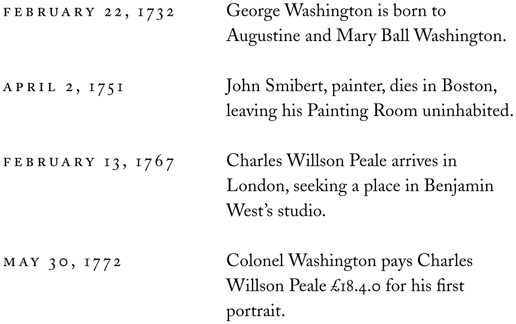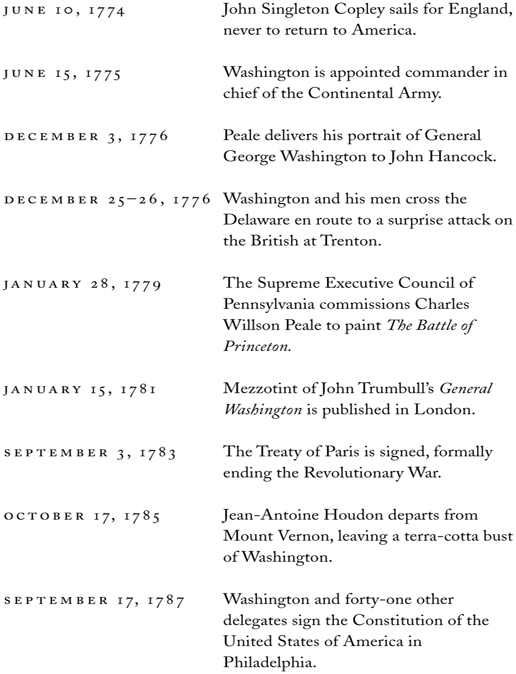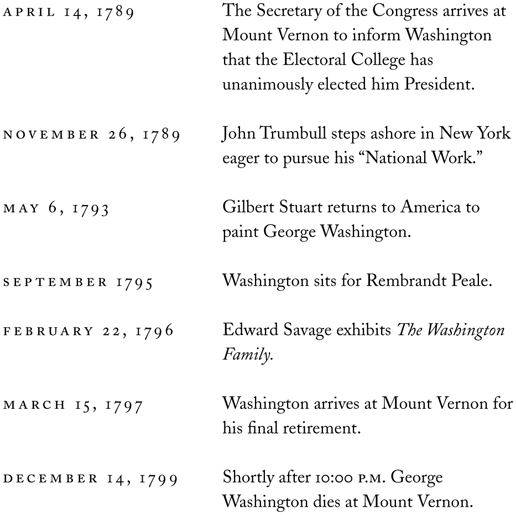The Painter's Chair (2 page)
Read The Painter's Chair Online
Authors: Hugh Howard

If Washington should appear on earth, just as he sat to Stuart, I am sure that [he] would be treated as an imposter, when
compared with Stuart’s likeness of him, unless he produced his credentials.
—John Neal,
Randolph
(1823)
1
I.
December 12, 1799 . . . The Mansion House . . . Mount Vernon, Virginia
G
EORGE WASHINGTON WAS late for dinner. This was not usual—like the crew on a well-disciplined ship, the Mount Vernon household
normally ran as if on military time.
On most days the General rose early, usually between four and five o’clock. He descended to his study, lit a fire, performed
his toilet, and dressed before devoting quiet hours to reading and writing letters. He expected to sit to his breakfast promptly
at seven, where he took tea (without cream), and ate corn cakes with butter and honey. He called them Indian cakes; they were
his preference, in part, because they required little chewing by his balky dentures. Although he had given up hunting, he
was still vigorous, taking plea sure in daily ten-, twelve-, or even fourteen-mile rides to survey his farms. This day had
been no exception as he had ridden out at ten o’clock. Now, as the minutes ticked by, the accepted dinner hour of three o’clock
had passed, and there was no sign of the General.
Though the moon had been visible the evening before, a northeast wind delivered a cover of clouds during the night. In the
early afternoon, several hours after the horseman departed, snow had begun to fall. The mercury continued to hover near the
freezing mark (Washington on rising had noted the temperature was thirty-three degrees). From the windows of the Mansion House,
Martha Washington—short, round, and businesslike in her movements—could see the snowflakes had given way to hail, then to
a steady, cold rain. She knew her husband would be hungry and in a need of hot food on his return. The meal would be postponed
until his arrival.
Yesterday the Washingtons had entertained guests, including Lord Fairfax, a British peer and an old friend of the family.
They had dined in the New Room, the large and grand dining room with its two-story ceiling. On this afternoon, however, with
little more than family on hand (Tobias Lear, Washington’s trusted secretary, was at his desk, laboring on the General’s correspondence),
a fire had been laid in the corner fireplace of the more intimate Small Dining Room. There the light from the flames reflected
off the looking glass suspended between the two windows, illuminating the lacy decorations on the white plaster ceiling, brightening
the brilliant verdigris of the walls. Like many of his contemporaries, Washington thought the color green relaxing. He termed
it “grateful to the eye.”
The delay was not so long. The General arrived shortly after the hour, and, met by Mr. Lear with the day’s correspondence,
he advised his younger friend, a sea captain’s son from New Hampshire, that there would be no posting of letters this evening.
The weather, he reported, was too bad to dispatch even a servant. Washington doffed his greatcoat, which was thoroughly wetted
by the snow and rain, but assured Lear that he himself was dry. Without a change of dress, he proceeded to his repast, by
the light of tall tapers that the servants had lit on learning of his return.
When he joined Martha at the table, they became the second set of Washingtons in the dining room that day. Along with the
aging Martha and George were likenesses of themselves, as recorded by artist Edward Savage. Mounted in the overmantel, in
a varnished gilt frame sent to Washington by the artist himself, the copperplate engraving of the painting
The Washington Family
portrayed the uniformed general and Martha in her mobcap seated at another table, along with their two wards, Martha’s grandchildren,
Eleanor Custis and George Washington Parke Custis (familiarly known as “Nelly” and “Wash”). The print offered a retrospective
view—Savage had begun its composition ten years earlier, when Wash and Nelly were still children. Behind the family stands
a slave resembling William Lee, Washington’s trusted manservant, waiting to serve. The engraving hung in a place of honor
in the warm and intimate room.
Although she was in residence at Mount Vernon, this night Nelly would not join the family at the table. Washington had helped
raise his step-granddaughter from infancy, and only the previous February she had done him the honor of marrying in Mount
Vernon’s parlor. She chose the nuptial day—it was Washington’s own birthday, the twenty-second— and she had taken her vows
as the sun descended. “Miss Custis was married ab[out] Candle light,” wrote Washington in his diary, “to Mr. Law[rence] Lewis.”
2
The groom was his nephew, son of his sister Betty.
In the months since, Nelly Custis Lewis and her husband had taken a wedding tour to visit friends, from which she returned
large with child. She and her doting grandmother Martha had busied themselves that fall preparing for the arrival of the “sweet
stranger,” as they called the baby. On this day, the cries of the newborn could be heard echoing in the upstairs halls, and
Nelly and the child, born November 27, remained confined to the second floor. Nelly’s brother, eighteen-year-old George Washington
Parke Custis, was also absent from the domestic scene at dinner, having ridden off on Monday in the company of his brother-in-law
to review some of the property Wash had inherited from his late father.
As he ate, Washington ignored the dampness, but Lear noticed that his neck was wet, that snow still hung from the portion
of his hair that had not been protected by his hat. To Washington, the storm outside mattered little. Warmed by the nearby
fire, he consumed the meat, vegetables, and hot breads put before him. He was in the bosom of his family, in the house he
had remade for Martha, a place that was a safe haven to three generations. Since their marriage in 1759, Martha and George
had called the place home. She had arrived with her two surviving children from her first marriage; years later, after the
death of Martha’s last surviving child, her son Jacky, in 1783, Wash and Nelly, his two youngest children, had resided there,
too, under the tender ministrations of the Washingtons. More recently Lawrence Lewis had moved in. His uncle had invited the
young widower to Mount Vernon to act as a social secretary, but Lawrence and Nelly had soon been drawn to one another. Their
marriage resulted in the newest arrival, newborn Frances Parke Lewis, the great-grandaughter known affectionately as Parke.
George Washington—General, President, Founding Father—was now retired after decades of public service. Here at Mount Vernon
he inhabited the world as he would have it, a place peopled with the loved ones Mr. Savage’s print had recorded. Issued just
the previous year,
The Washington Family
was already a modest success, but, given the events that unfolded in the next two days, it would soon become one of the most
popular images of the day for the saddest of reasons.
II.
Friday the 13th . . . The Mansion House . . . Mount Vernon, Virginia
T
HE PREVIOUS EVENING had proven uneventful, but first light revealed a landscape newly blanketed in white. Snow continued to
fall throughout the morning, and three inches accumulated on the ground by midday.
The General had awakened to the realization that a cold was upon him. He complained to Martha of a sore throat. Given the
inclement weather, he agreed to forgo his usual ride around his acreage. Instead, he retired to his study to tend to the correspondence
and other paperwork that always seemed to await him.
If the Mansion House at Mount Vernon was the face he wanted the world to see, then his study at the building’s south end was
the essence of the man himself. The large room with the private stair from his bedchamber above was his architectural thinking
cap, a retreat from visitors and even family. The room, grandson Wash Custis explained, was “a place that none entered without
orders.”
3
A tall bookpress dominated the east wall. Through its wavy glass doors could be seen most of the 884 bound volumes in Washington’s
library. Like the man himself, much of his collection of books was devoted to practical matters such as military strategy,
the law, geography, and agriculture. Classical authors were represented, along with such eighteenth-century contemporaries
as Jonathan Swift, Robert Burns, and Adam Smith. Washington also owned a volume of Alexander Pope’s translation of
The Odyssey
, its title page adorned with Washington’s signature. With a certain poetic symmetry, the tale it told was of another victorious
general who required many years to make it back to his beloved home.
On a shelf in his library was an early notebook in which the adolescent Washington had copied out 110 maxims from a book titled
Rules of Civility and Decent Behavior in Company and Conversation.
The advisories ranged from matters of etiquette (“Cleanse not your teeth with the tablecloth”) and economics (“The man who
does not estimate
time
as
money
will forever miscalculate”) to aphorisms about conscience, respect, composure, and affectation. Taken together, they amounted
to a primer for an awkward young man trying to master the social graces in a colony where manners mattered a great deal.
Very much later, Washington had begun his final retirement at Mount Vernon. In March 1796, having watched wordlessly at the
ceremony for John Adams’s swearing-in as the second president of the United States, he had climbed into his carriage for the
journey back to Virginia. As Nelly wrote to a friend shortly after their return, “Grandpa is very well, and much pleased with
being once more Farmer Washington.”
4
She spoke the truth, but his correspondence indicates that Washington remained in intimate contact with the political world
he had shaped.
Whenever he worked in the study, he did so under the gaze of Lawrence Washington, whose portrait hung between the south-facing
windows. After their father’s death, when George was eleven, Lawrence had become his half brother’s mentor, introducing the
teenage George to aristocratic Virginia society. Lawrence had married a niece of Lord Fairfax, a Yorkshireman whose American
holdings amounted to more than five million acres between the Potomac and Rappahannock rivers. The impressionable George liked
almost everything that he saw at Belvoir, the Fairfax plantation just downstream from Mount Vernon. He spent a great deal
of time at the grand brick house, where foxhunting and dancing parties were commonplace. The family’s connections taught him
much about the expectations of fashionable society and also launched George’s first career. The Fairfax influence played a
role in his employment as a surveyor in laying out the new town of Alexandria and mapping portions of the Shenandoah Valley.
Washington had idolized his brother. An experienced soldier, Lawrence helped inspire in the boy a desire for military glory.
When George was nineteen, the brothers had traveled together on what would be the future president’s sole journey beyond the
borders of the thirteen colonies. Although their 1751 trip to Barbados was intended to help cure Lawrence of his nagging cough,
it served only to expose George to smallpox. Lawrence nursed him through his bout with the disease, but his own consumption
advanced, and by the following year he was dead. One eventual consequence was that George inherited Mount Vernon after the
premature death of Lawrence’s only heir.
Although he had twice radically remodeled his brother’s house—the first time to welcome his wife when he and Martha married
in 1759, then later during the Revolution—he honored Lawrence’s memory. When the General worked at his desk, it was Lawrence
who was positioned to look over his shoulder. The painting, bearing no artist’s signature, was a poor likeness. The face was
masklike, and the man’s red jacket and green waistcoat were suspended on the torso like paper-doll clothing. The painted likeness
was recognizable as his brother, but, compared to other art in his house hold, its maker’s skills were primitive.
Two other worthies peopled the study, both of them artworks of a more sophisticated kind. One was a workshop plaster cast
of a bust of America’s great naval hero, John Paul Jones. The other was no copy: It was an original bust of Washington from
the hand of the French master Jean-Antoine Houdon. From its perch atop a bracket, the terra-cotta head appeared to be gazing
across the room, as if musing over the books on the upper shelves in the bookpress. The Washington bust had been made on these
very acres during the Frenchman’s visit to Mount Vernon fourteen years earlier.
One of the world’s greatest artists, Houdon had come to Mount Vernon at the invitation of Benjamin Franklin and Thomas Jefferson.
After a fifteen-day stay at the plantation, Houdon returned to his Paris studio, carrying with him a plaster life mask he
had made of Washington. But at Mount Vernon he left as a gift to his host his first sculpted likeness. Made of clay dug from
the Virginia soil and fired in a Mount Vernon bake oven, the bust bore Houdon’s own fingerprints. The consensus among Washington’s
friends and family was that the Frenchman had captured George Washington as no other artist had done.
That December morning, just days before his century ended, the great man paid little attention to the images around him. Through
a wide window he could gaze down the hillside, now covered in snow, sloping to the shore of the Potomac. Nearer at hand was
a globe, one he had ordered from London, “a terrestrial globe of the largest dimensions and of the most accurate and proved
kind now in use.”
5
As the founder of a new nation, he had helped reshape the world, yet on this day Washington’s thoughts were of a more immediate
kind.


